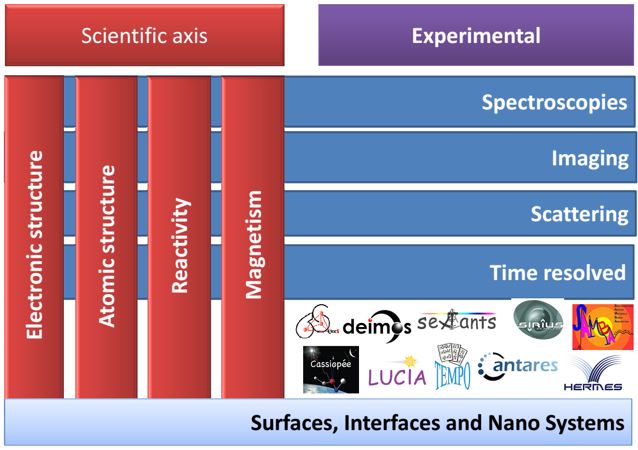The common interest of the scientific section is the low dimensionality and the description of the unique properties of materials when at least one dimension is reduced to few atoms. The electronic, magnetic and structural properties are modified because of the broken symmetry and the presence of the surface or of an interface.

L'équipe
Les membres
|
|
|
|
Les associés
- Bournel Fabrice
- Gallet Jean Jacques
- Garreau Yves
- Gatti Matteo
- Goldman Michel
- Hague Coryn
- Luning Jan
As secondary section
- Asensio Maria Carmen
- Fontaine Philippe
- Ohresser Philippe
- Vlad Alina
| Research | |
|---|---|
| Techniques |
Photoelectron emission : Angular Resolved PES | XPS | Time-resolved studies Scattering | Small angle scattering Absorption : XMCD | Time-resolved studies Imaging : Photoemission electron microscopy (PEEM) |
Activités de recherche
The research activity can be classified as fundamental, but is strongly motivated by technological applications. The aim is to discover new phenomena, understand the main principles which bring to the special properties interesting
- in nano and environmental science or energy conversion. Examples are
- oxides surfaces and heterojunctions,
- topological insulators,
- electronic and magnetic properties of strongly correlated systems,
- natural and artificial multiferroics,
- interplay between structure/morphology and
- electronic properties at surfaces.
- Nearest to application for electronic devices, a part of the activity is dedicated to Graphene and 2D materials.
- A third subject can be identified in surface reactivity related to chemistry and catalysis.
- The fourth scientific subject is magnetism and the study of magnetic materials for Spintronics as well as for static and dynamic magnetic properties of sub-micron devices.
Thématiques scientifiques
Electronic Structure
Soft x-rays and VUV radiation are the main tools to study electronic structure of material. The strong interaction with electrons (high cross section) and the characteristics of synchrotron radiation (Intense, tunable, monochromatic photons) are used to study the details of the electronic structure in order to predict the related electronic properties.
Atomic Structure
The position of atoms at surfaces and interfaces can be found in arrangements which are not currently found in bulk materials. The study of atomic positions at surfaces and interfaces can be done using soft X-ray combined with spectroscopy and with hard X-rays in surface sensitive geometries.
Reactivity
Three beamlines use complementary techniques to study the interaction of molecules with surfaces and catalytic processes in operando conditions. Electronic properties are studied by Near Ambient Pressure photoelectron spectroscopy (NAP-XPS), surface structure at the atomic level is studied by surface diffraction and other hard x-ray techniques.
Magnetism
Circular polarized x-rays and surface and interface properties are the keywords which identifies this section. The main research subjects are material science for Spintronics as well as static and dynamic magnetic properties of sub-micron devices.
Techniques expérimentales
Spectroscopies
Spectroscopy is the most important tool for the Surfaces, Interfaces and Nano Systems scientific section; a spectroscopic technique is used on all beamlines. Photo absorption and photoemission spectroscopies as well as inelastic X-ray scattering are declined in with several acronyms depending on the application: XANES (X-ray Absorption Near edge Spectroscopy), XMCD (X-ray Magnetic Circular Dichroism), ARPES (Angular Resolved Photo Electron Spectroscopy), XPS (X-ray Photoemission Spectroscopy), ESCA (Electron Spectroscopy for Chemical Analysis).
Imaging
Third generation sources are characterized by a high photon flux and a high brilliance. The many photons in a small focal spot can be used for microscopy experiments detecting electrons or photons. The atomic and chemical sensitivity which can be obtained with spectroscopy make of these stations unique tools available at synchrotron radiation sources. Examples
Scattering
Soft X-Ray elastic and inelastic scattering are powerful techniques to study electronic and magnetic properties of materials. The wavelength of soft X-rays is particularly well adapted to magnetic domain size. Examples
Time resolved
The high flux of third generation sources can be used to obtain sufficient statistic when we want to extract information on material properties changing on a short time scale. Experiments can be performed at several time scales ranging from millisecond to picosecond. At shorter time scales the SOLEIL time structure is used in pump/probe experiments coupling laser, electric or magnetic pulses to study short excitations.
Evènements
- Hercules
- Surface School
- Seminars









